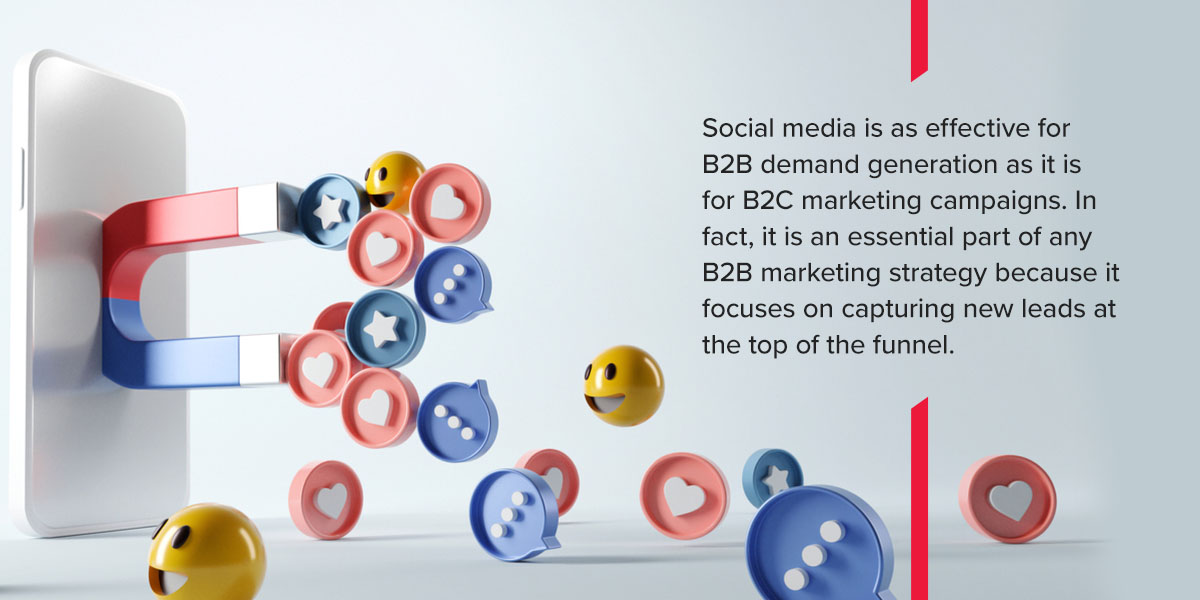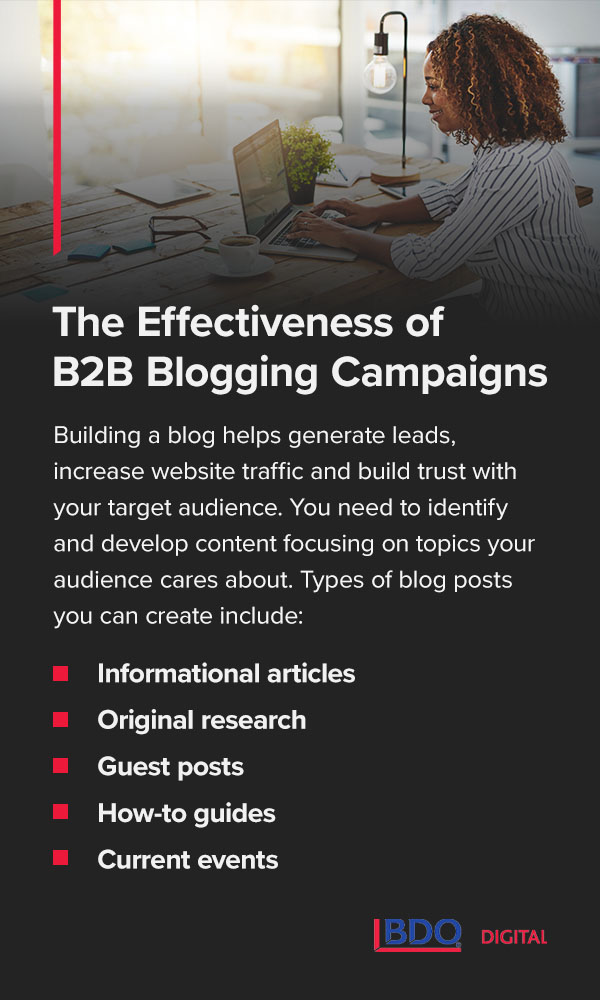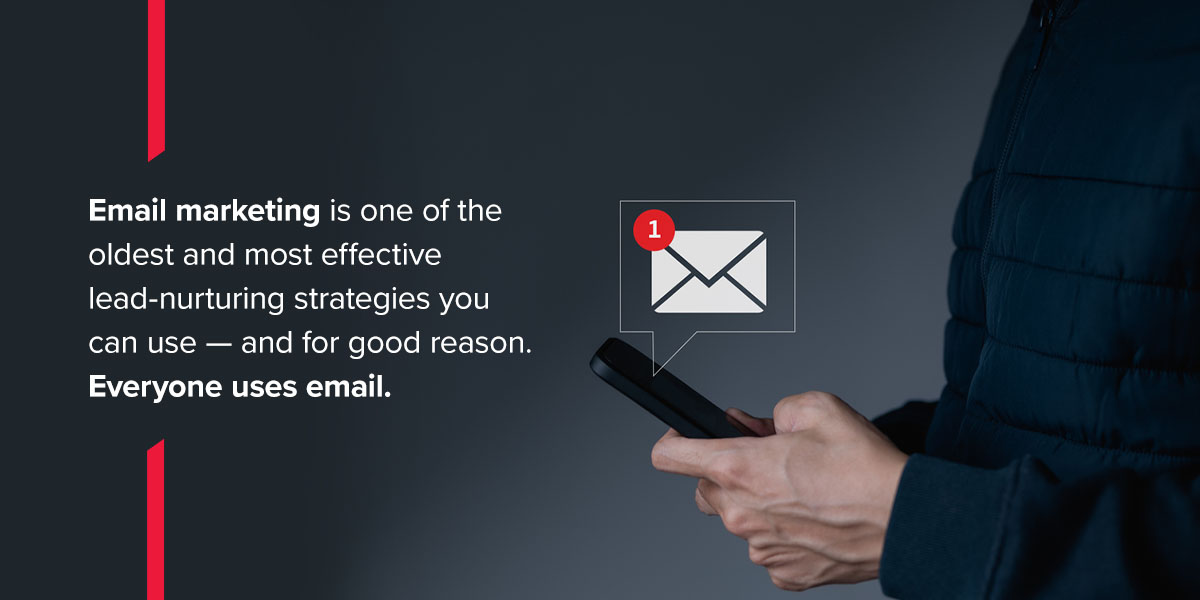A Recap of the Most Successful B2B Demand Generation Campaigns in 2022
A Recap of the Most Successful B2B Demand Generation Campaigns in 2022
What makes a great lead generation campaign? Is it high-quality ads? Clever calls to action (CTAs)? Consistent content creation? The answers depend on a wide variety of factors, including your industry and your target audience.
When building a demand generation strategy, B2B marketers have to consider how these factors affect the message they want to send. Learning from successful campaigns can provide some inspiration for future efforts and improve your strategies.
What Is B2B Lead Generation?
B2B lead generation is a key component of B2B demand generation that focuses on drawing new leads, or prospective customers, to your business through careful attention to detail and strategic advertising.
Demand generation is a strategy for accelerating business growth through increasing brand awareness and creating demand for the products or services your business offers. Marketers often use B2B demand generation strategies in conjunction with other marketing methods to generate more organic results.
Lead types typically vary between different campaigns and marketing platforms. The key with B2B marketing is delivering the correct message to the right person at the right company, which is significantly more targeted than marketing to the average consumer.
Once you have captured your leads, you interact with them to gauge their interest in your offerings. This lead nurturing process helps guide them through your sales funnel, when they convert into customers by making a purchase.
The B2B Demand Generation Funnel
The demand generation funnel is the process prospective buyers go through before becoming your customers. It breaks down into three distinct stages:
- Top: The top-of-funnel stage focuses on building brand awareness among your target audience.
- Middle: In the middle stages, companies have become familiar with your brand. They conduct research and interact with you to determine whether your offerings are something they need.
- Bottom: At the bottom of your funnel, prospects convert into customers by making a purchase. This stage produces valuable information for understanding buyer intent and what arguments convince prospects to convert.
A critical consideration at every stage of the funnel is communicating the business value your product or service can provide your customers. You need to remain conscious of the fact that you are targeting decision makers at other companies rather than end users or general consumers.

Social Media Strategies in B2B Marketing
Social media is as effective for B2B demand generation as it is for B2C marketing campaigns. In fact, it is an essential part of any B2B marketing strategy because it focuses on capturing new leads at the top of the funnel.
Because they operate on the top two social media platforms in the world, LinkedIn Ads and Facebook Lead Ads are the most lucrative channels for B2B social media marketing. Here are some of the advantages of each:
- Facebook: Facebook Lead Ads provide a smooth lead generation experience by allowing prospects to fill out forms and sign up for offers without ever having to leave the Facebook app. While this integration makes it ideal for mobile lead generation, it is still important to optimize your landing page to gain leads from organic search and paid advertising.
- LinkedIn: LinkedIn Ads are excellent for leveraging social proof through content such as case studies and testimonials. The platform shows prospective customers how your offerings have helped other organizations within their network, which builds trust in and awareness of your brand.
Here are some B2B demand generation ideas you can use for social media campaigns.
1. Leveraging Urgency: Virgin Active South Africa
Creating and promoting a limited-time offer makes your product or service appear more valuable to your customers, thus increasing the chances they will provide their information.
Although this example is B2C, the concept applies to B2B marketing. In mid-2019, fitness club franchise Virgin Active South Africa offered a free three-month gym membership to users who signed up before October 21.
Another unique aspect of this campaign is that it skips the lead generation and nurturing steps entirely. Users who clicked the CTA and completed the form became gym customers immediately rather than email marketing subscribers.
2. Demonstrating Value: DigitalMarketer
Sometimes, you have to give in order to get.
In their recent Facebook Ad campaign, DigitalMarketer embraced this truth by providing prospects with free downloadable ad templates. Prospects who download the templates can then test them out in their own campaigns to determine whether they save time and improve sales.
This strategy captures leads by creating a clear value proposition, which increases the likelihood that users will share information with the company. Additionally, by providing freebies, the ad encourages viewers to reciprocate by engaging with the company once they determine that they like the offering.
3. Mastering the CTA: Van Gogh Sacramento
An enticing CTA makes your viewers more likely to click, and Van Gogh Sacramento's Facebook ad campaign for the Beyond Van Gogh immersive experience presents a brilliant example.
The simple phrase “Book Now” creates a sense of urgency for the viewer, encouraging them to book a ticket before the event sells out. Additionally, the ad's descriptive copy and high-quality image complement each other to show the viewer the kind of visual experience they can expect at the event.

The Effectiveness of B2B Blogging Campaigns
Building a blog helps generate leads, increase website traffic and build trust with your target audience.
It is important to remember that blogging is most effective in combination with other content marketing techniques. Typically, strong content marketing campaigns use various different media formats to engage the target audience, such as blog posts, podcasts, videos, white papers, infographics and more.
Regardless of format, this content should align with your organization's overall marketing goals. You need to identify and develop content focusing on topics your audience cares about. Types of blog posts you can create include:
- Informational articles: Educate your audience on topics you have expertise in. This builds trust with your audience by demonstrating your organization's expertise.
- Original research: Organizations often publish original studies for industry use. To provide the most value, focus on updating outdated data sets or tackling topics that have not yet been covered within the industry.
- Guest posts: Recruiting thought leaders and influencers in your industry to write regular opinion pieces and articles can help boost SEO efforts and improve your brand's image.
- How-to guides: Provide easy-to-follow tutorials and tips that can help prospects resolve problems they may be experiencing.
- Current events: You can take advantage of trending topics in your industry to attract new eyes to your blog through organic means.
Including various types of blog posts diversifies your blog and helps you create content tailored to specific segments of your audience. Through consistency and diversity of content, these companies have effectively incorporated blogging into their content marketing campaigns.
1. Targeting the Right Audience: FreshBooks
Without a solid understanding of your target audience, creating excellent and engaging content is challenging at best and impossible at worst.
Consider FreshBooks, an accounting firm that provides services specifically to small businesses. FreshBooks knows who its audience is, and the front page of its blog makes it immediately clear who they are trying to reach by explaining its blog's value at the top of the page. All their posts perfectly match their audience, and their blog offers various forms of content, including articles, ebooks and case studies.
2. Leveraging Multiple Media Channels: HubSpot
Leave it to marketing companies to nail content marketing. HubSpot publishes a wide range of content on its website, including but not limited to:
- Videos
- Ebooks
- White papers
- Listicles
- Ideas
- Reports
- Insights
- Tips
By providing helpful content in diverse formats, HubSpot is able to outperform even media giants like Forbes and CNN Money in Google SERPs for inbound marketing. This brings in plenty of organic traffic, resulting in more leads and conversions.

Email Marketing Lead Generation Strategies
Email marketing is one of the oldest and most effective lead-nurturing strategies you can use — and for good reason. Everyone uses email. In 2022, people sent and received an estimated 333.2 billion emails per day. This massive readership means you can expect good returns. The average ROI for an email marketing campaign is $36 for every $1 spent.
Additionally, evolving technologies like automation and AI algorithms streamline email marketing by allowing you to rapidly personalize and send massive amounts of emails, which can further boost your ROI.
What Makes a Successful Email Marketing Campaign Strategy?
While email marketing is simple in theory, there is a lot that goes into creating a successful campaign. Some of the key factors that can affect conversion rates include:
- Lead magnet: A clear, enticing value offer is what gets people to sign up. That value can come in the form of high-quality content, discounts, freebies or anything else your audience might be interested in.
- Landing page optimization: Display your lead magnet clearly along with a compelling CTA and appealing visuals for the best results.
- Segmentation: By splitting your subscriber list into audience segments, you can create more targeted messages, which can increase your click-through rate (CTR).
- Subject lines: Concise and compelling subject lines clearly communicate to the recipient why they need to open your emails.
- Predictive analytics: Analytics software makes it easy to understand recipient behavior and clean up your mailing list accordingly.
Following are some tips and tricks for optimizing your B2B email marketing strategy.
Use Compelling Stories
Email marketing is all about getting your message across to your recipients, which is why good storytelling is one of the best ways to captivate your readers. You can use various types of stories, such as:
- Testimonials: You can include stories that how your product or service has benefited previous customers to build trust with your readers and inspire them to convert.
- Behind-the-scenes: If you are releasing a new product or service, include the story of how the new offering came to be. Tell your customers what inspired each new feature — this is also a great way to show its business value.
- Funny anecdotes: Begin with a seemingly unrelated story and find a clever way to tie it to your offerings. This technique hooks the reader by providing entertainment value and getting them interested in your business.
Including well-placed links to product or service pages, CTA buttons and contact forms in your stories can help convert leads into customers.
Leverage Humor and Wit
Clever, witty emails make your brand stand out from your competition. More specifically, in B2B marketing, inside jokes or industry humor can build trust with your audience by demonstrating your understanding of the business.
Here are some ideas:
- Write creative CTAs: Email CTA buttons provide an excellent opportunity to add some personality to your message. For example, a food delivery service might use a CTA like “Feed Me!” or “I'm Hungry!”
- Use a witty subject line: Because the subject line is the first thing your viewer will see, it presents an excellent opportunity to
- Use clever visuals: Adding funny images or clever visual allusions to your emails can make them more enjoyable to read. Memes, original cartoons and fun graphics can all work when used correctly.
As with any other type of content, knowing your target audience is critical for making sure your jokes land well. If your industry is typically more professional and serious-minded, using humor can be a double-edged sword — whether your message interests or puts the reader off depends heavily on the individual.
Clean House When Necessary
One of the most common issues with email marketing is the tendency to build large lists of email subscribers, many of whom stop opening your emails after a few messages.
Cleaning up your data at regular intervals using automation and AI technology can help you improve campaign performance by:
- Reducing your bounce rate: If your recipient changes email addresses, or if their email inbox fills up, your message will bounce back to you. Removing uninterested or unreachable recipients from your email list ensures you maintain only prospects who are interested in reading your emails.
- Improving your sender reputation: A high bounce rate alerts email service providers (ESPs) that you may be a spammer — this can result in your emails ending up in prospects' junk or spam folders. In contrast, ESPs respond to low bounce rates by allowing your messages to land in the recipient's regular inbox, where they are more likely to see it.
- Increasing engagement: Keeping clean email lists creates a more targeted contact list, which allows you to focus on the subscribers who are genuinely interested in your offerings. That way, you can tailor your content to their needs and interests.
One way to maintain high-quality leads is by filtering out inactive subscribers with “breakup emails.” Before removing an email address from the list, send an email telling them you are sorry to see them go with a CTA button they can click to remain on the list. Then, remove any subscribers that do not opt in.

Learn More About the D3 Methodology From BDO Digital
When it comes to lead and demand generation in B2B marketing, providing high-quality content is the most important consideration. Creating great content and interesting advertisements shows your offering's value, demonstrates your brand's expertise and builds trust with potential customers.
If you are looking to improve your B2B marketing strategy, BDO Digital's demand generation solutions can help you get where you need to be. We developed the D3 Methodology to provide marketers with everything they need to maximize revenue output in B2B marketing campaigns.
By optimizing the disciplines of demand creation, demand management and demand expansion, we empower our customers to build a perpetual, high-functioning revenue engine. For more information on how you can use the D3 Methodology to enhance your demand generation strategy, reach out to us online. Our team is here to answer your questions.

SHARE